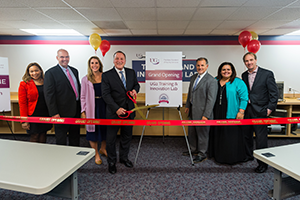
In the war for talent, experienced tradespeople are among the hardest candidates to find. As more high school students pursue four-year college degrees and apprenticeship programs become less common, teenagers have fewer avenues to launch a career in plumbing, HVAC and other trades. Fully 62 percent of organizations in these industries say they are struggling to fill key roles. At the same time, a large portion of the existing workforce is nearing retirement, with more than half now over the age of 45, according to data from staffing agency Adecco.
This growing talent crisis is forcing commercial operations and maintenance companies to rethink their talent development strategy or risk an inability to support future growth. “Today’s tight labor market combined with an aging skilled trade workforce means that we need to invest in building our team,” said Jim Lane, senior vice president of operations and maintenance for UG2, a privately held facility services organization based in Boston. And he’s got just the plan to do it.
Training Drives Sustainable Growth
UG2 is just 7 years old but already has 3,300 employees in 17 states with new clients coming on board all the time. It’s exciting for the company, but this rapid rate of growth puts constant pressure on the team to attract, retain and develop operations and maintenance professionals who can meet the needs of its expanding customer base for the long term. “If we are not preparing our people for three, five and 10 years out, we are always going to be behind,” Lane said.
Rather than scouring the country for experienced tradespeople, UG2 is taking a more proactive approach to building its workforce from within.
Lane was brought on board in 2017 to help develop a long-term business plan that could support sustainable growth. That includes a talent strategy that is built around UG2’s philosophy of hiring “PHDs” — people who are “passionate, hardworking and dedicated to the industry,” then training them to succeed. “Once we find them, my job is to give them the tools to get there,” Lane said.
He believes that if UG2 can provide new hires with training on skills that are needed across different roles in the company, recruiters can open hiring to a broader pool of candidates who may not have specific experience but who have the passion to learn. The training will also make it easier for people to move up through the ranks, from basic janitorial roles to more high-tech maintenance and operations positions.
The key to all of this agility and growth was construction of a state-of-the-art innovation training lab at the company’s headquarters in Boston where employees can learn all the skills they need to thrive on the job. Along with running an apprenticeship program to train local high school students on operations and maintenance roles and then hire them upon graduation, in 2018 the company built the lab to close the talent gap and give new and existing employees the tools to build a career at UG2, said Lauren Lanzillo, director of organizational development. “This lab is an opportunity for us to differentiate ourselves from other service providers in the ongoing war for talent.”
Hands-On Crash Course
The lab is an open space with multiple shared work tables and screens to support videos and presentations. It also features working equipment donated by customers and vendors, including a ductless split air conditioning unit, soldering tools and a functioning control board that trainees can use to practice maintenance and operations tasks. “Our guys can become familiar with the technology so they can learn to do that work,” explained Tom McKenna, operations and logistics manager.
UG2 will bring in outside experts to teach a variety of courses, which run from one day to six weeks. All of the content is built around specific UG2 customer needs. The current lineup includes courses on pumps, seals and alignment, building automation systems and tools, and HVAC and Multistack systems. They will also teach soft skills courses on customer service excellence, business writing and time management to help employees develop the service skills they need to move up through the ranks.
Because these courses are specifically designed for UG2 employees and customers, they are more valuable than a typical trade school crash course, Lane said. “In trade school programs there is no hands-on work,” he said. Whereas in the lab, his team gets to practice soldering, pipefitting, fixing circuit boards and troubleshooting equipment.
“We are able to tailor the training to the sites where they will work, so they can become familiar with what they are likely to see before they get there,” said Louis Lanzillo, UG2’s CEO.
This hands-on approach serves multiple goals for the business. By customizing the content to the needs of specific clients, UG2 ensures its staff know exactly what each building needs and how to respond if equipment malfunctions. “If our guys can do that work, our clients don’t have to call in expensive subcontractors to fix it,” McKenna said. That saves them money and builds client loyalty.
At the same time, these courses are giving new and existing employees a way to develop new skills and acquire industry certifications so they can see themselves having a long-term career with UG2. The courses fill an important training need for today’s operations and maintenance workforce, McKenna said. When he got his first job in this industry, his manager, who had been on the job 40 years, spent a month taking McKenna into the field every time he had a service call to show him the ropes and let him watch other techs on the job. “He did that so I could learn,” he said.
The hands-on courses being developed by UG2 are giving the current generation of employees a similar experience. By providing them with a safe space to become familiar with commercial equipment, and to practice tasks together, it closes a gap in their training.
Free For Everyone
To make training as easy as possible, UG2 has opened every course to every employee, though they target specific groups who stand to benefit the most. Employees don’t need permission to participate and there are no costs associated with signing up. The courses are also scheduled to occur at the end of shifts and on weekends to make participation easy. “They just need to show up and learn,” McKenna said.
Employees have been extremely receptive. McKenna noted that the first classes filled up immediately, and many of his team have asked to have them run again.
Younger workers in particular are excited about the training because it means they can develop skills without having to attend expensive off-site trade schools, Lane said. “We’ve gotten a great response from our younger folks, which is one of our biggest goals for the lab.” Although he’s equally excited to work with midcareer professionals who aspire to more senior roles, or to move from maintenance to operations.
It’s still in its early days, but UG2 believes that the courses they are offering, in combination with other training, mentoring and apprenticeship programs, will ensure the company can attract and retain top talent to support its ongoing growth. “When you have a happy workforce who can see a path to success it helps with retention,” Lane said. “And they will tell their friends.”
Lane added that many of UG2’s clients are surprised that other firms are not taking the same proactive approach to training as a way to manage the talent shortage in the industry. “You can’t get so tied to the bottom line and driving performance that you forget to innovate,” he said. “Even if you have the best people you have to do your part to give them the knowledge and skills they need to be successful or you can’t continue to grow.”














